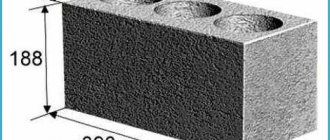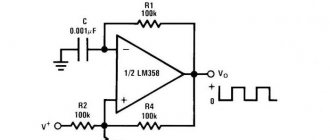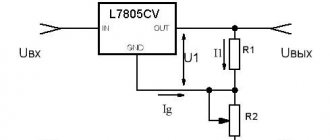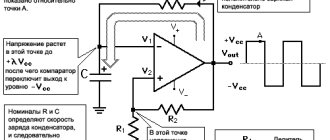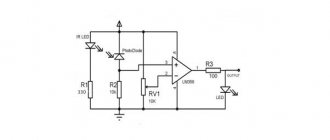Connection diagram ULN2003A
The ULN2003A chip is a set of composite switches with a wide range of applications. The matrix can be used to control high power loads in various modern projects, for example, to control LED indicators, solenoid valves and relays, stepper motors, DC motors, etc. The module has a 16-pin compact package with seven channels (Darlington transistors). All exits and entrances are located opposite each other, which is very convenient. The device has a compact size. Read about other technical parameters below:
- voltage (maximum): up to 50V;
- peak current: 600 mA (per channel - 500);
- coil power: 12-48V;
- body type: SO-16;
- operating temperatures: -60°C…+150°C;
- there are protective diodes at the output;
- fill factor: 100%.
Electrical diagram:
Important! When designing circuits with this module, you should pay attention to the current control thresholds.
Because the microcircuit is universal, but still designed to work with p-MOS logic (5V), in the future we will look at connecting the ULN2003A to Arduino using a unipolar stepper motor (the model can be any). With such motors, this module usually works in pairs. Both are budget-friendly and get along great.
To implement the assembly, we will need the following hardware components: Arduino Mini microcontroller, BYJ48 5V motor, ULN2003 driver, 5V power supply, wires.
The connection diagram for ULN2003A to Arduino is shown in the screenshot:
To program and further use the assembly, you need a sketch. It is standard and can be found in the IDE along the path: File/Examples. Let's connect.
Now we upload the firmware:
/* Sketch for the BYJ48 stepper motor Connection diagram: IN1 >> D8 IN2 >> D9 IN3 >> D10 IN4 >> D11 VCC ... 5V. It is better to use an external power supply Gnd Author of the code: Mohannad Rawashdeh Details in Russian: /arduino-shagovii-motor-28-BYJ48-draiver-ULN2003 English version: https://www.instructables.com/member/Mohannad+Rawashdeh/ 28 /9/2013 */ #define IN1 8 #define IN2 9 #define IN3 10 #define IN4 11 int Steps = 0; boolean Direction = true; unsigned long last_time; unsigned long currentMillis ; int steps_left=4095; long time; void setup() { Serial.begin(115200); pinMode(IN1, OUTPUT); pinMode(IN2, OUTPUT); pinMode(IN3, OUTPUT); pinMode(IN4, OUTPUT); // delay(1000); } void loop() { while(steps_left>0){ currentMillis = micros(); if(currentMillis-last_time>=1000){ stepper(1); time=time+micros()-last_time; last_time=micros(); steps_left—; } } Serial.println(time); Serial.println("Wait...!"); delay(2000); Direction=!Direction; steps_left=4095; } void stepper(int xw){ for (int x=0;x7){Steps=0;} if(Steps<0){Steps=7; } } As the user experience of using the microcircuit in question shows, it is quite a powerful and useful tool, which means it can be useful to many Arduino users and DIY enthusiasts.
Element-by-element analysis of the insides of a simple microcircuit - ULN2003
In previous articles with photographs of microcircuit crystals (, , ) - in the comments they wrote that it would be nice to disassemble a simple microcircuit in detail - so that it would be clear “what is what” at the lowest level, and where the “magic smoke” is hiding. For a long time I could not choose a microcircuit whose circuit could be understood in a few minutes - but finally a solution was found: ULN2003 - an array of Darlington transistors. Despite its simplicity, the chip is still widely used and produced. ULN2003 consists of 21 resistors, 14 transistors and 7 diodes. It is used to control a relatively powerful load (up to 50 volts / 0.5 amperes) from the pin of a microcontroller (or other digital microcircuits). The canonical application is to control powerful 7-segment LED indicators.
As follows. The colors are somewhat enhanced relative to natural ones; the metal under the contact pads is damaged by acid (and has acquired this brown color):
As you can see, 7 channels are absolutely identical, so we will consider only one. Fortunately for us, we know the diagram of each channel - and we can peek into it:
And now 1 channel with marked elements. I leave the comparison of specific elements to the diagram as homework for the reader.
But how is the transistor itself made? It is known that the internal structure of a planar bipolar npn transistor during production is as follows:
Thin base - “dives” under the emitter. Despite the fact that silicon is doped in type n on both the collector and the emitter, the dopant concentration and thickness differ: this is done in order to optimize the transistor for “current amplification” in one direction.
Knowing this, we can take a closer look at 1 transistor and understand where everything is. Silicon doped into different types is slightly different in color. This is practically invisible to the naked eye - but here the color saturation and contrast are turned up almost to the maximum. Don’t let 2 emitters connected in parallel confuse you - they work like 1 larger area.
To ensure that the connections do not “short-circuit” something that is not needed, the surface of the silicon is covered with a layer of transparent glass (SiO2), in which there are holes directly above the places where the pin connects to the desired location on the transistor. This can be clearly seen in the next photo, because... The depth of field on this lens is less, and for example the connection to the base is no longer in focus, because located higher, above the glass layer.
The collectors of both transistors are actually a single whole, because according to the diagram they are connected. Adjacent channels are isolated by a pn junction, you can see a slightly different colored rectangle around each channel in .
As you can see, there is no magic inside 
Datasheets
Found: 330,771 Output: 1-20
View: List / Pictures
- MAX4236AEUA+T — Datasheet Maxim
Operational amplifiers Maxim MAX4236 MAX4236AEUA+T
SOT23, Ultra-High Precision 3V/5V Rail-to-Rail Op-Amps MAX4236/MAX4237 are high-precision op-amps with exceptionally low offset voltage and offset voltage temperature coefficient without using...
- MAX4236EUT+T — Datasheet Maxim
Operational amplifiers Maxim MAX4236 MAX4236EUT+T
SOT23, Ultra-High Precision 3V/5V Rail-to-Rail Op-Amps MAX4236/MAX4237 are high-precision op-amps with exceptionally low offset voltage and offset voltage temperature coefficient without using...
- MAX4236EUT+ - Datasheet Maxim
Operational amplifiers Maxim MAX4236 MAX4236EUT+
SOT23, Ultra-High Precision 3V/5V Rail-to-Rail Op-Amps MAX4236/MAX4237 are high-precision op-amps with exceptionally low offset voltage and offset voltage temperature coefficient without using...
- MAX4236BEUA+T — Datasheet Maxim
Operational amplifiers Maxim MAX4236 MAX4236BEUA+T
SOT23, Ultra-High Precision 3V/5V Rail-to-Rail Op-Amps MAX4236/MAX4237 are high-precision op-amps with exceptionally low offset voltage and offset voltage temperature coefficient without using...
- MAX4236BEUA+ - Datasheet Maxim
Operational amplifiers Maxim MAX4236 MAX4236BEUA+
SOT23, Ultra-High Precision 3V/5V Rail-to-Rail Op-Amps MAX4236/MAX4237 are high-precision op-amps with exceptionally low offset voltage and offset voltage temperature coefficient without using...
- MAX4236BEUA — Datasheet Maxim
Operational amplifiers Maxim MAX4236 MAX4236BEUA
SOT23, Ultra-High Precision 3V/5V Rail-to-Rail Op-Amps MAX4236/MAX4237 are high-precision op-amps with exceptionally low offset voltage and offset voltage temperature coefficient without using...
- MAX4236BESA+T — Datasheet Maxim
Operational amplifiers Maxim MAX4236 MAX4236BESA+T
SOT23, Ultra-High Precision 3V/5V Rail-to-Rail Op-Amps MAX4236/MAX4237 are high-precision op-amps with exceptionally low offset voltage and offset voltage temperature coefficient without using...
- MAX4236BESA+ - Datasheet Maxim
Operational amplifiers Maxim MAX4236 MAX4236BESA+
SOT23, Ultra-High Precision 3V/5V Rail-to-Rail Op-Amps MAX4236/MAX4237 are high-precision op-amps with exceptionally low offset voltage and offset voltage temperature coefficient without using...
- MAX4236BESA - Datasheet Maxim
Operational amplifiers Maxim MAX4236 MAX4236BESA
SOT23, Ultra-High Precision 3V/5V Rail-to-Rail Op-Amps MAX4236/MAX4237 are high-precision op-amps with exceptionally low offset voltage and offset voltage temperature coefficient without using...
- MAX4236AEUA - Datasheet Maxim
Operational Amplifiers Maxim MAX4236 MAX4236AEUA
SOT23, Ultra-High Precision 3V/5V Rail-to-Rail Op-Amps MAX4236/MAX4237 are high-precision op-amps with exceptionally low offset voltage and offset voltage temperature coefficient without using...
- MAX4236AESA+ - Datasheet Maxim
Operational amplifiers Maxim MAX4236 MAX4236AESA+
SOT23, Ultra-High Precision 3V/5V Rail-to-Rail Op-Amps MAX4236/MAX4237 are high-precision op-amps with exceptionally low offset voltage and offset voltage temperature coefficient without using...
- MAX4236AESA - Datasheet Maxim
Operational Amplifiers Maxim MAX4236 MAX4236AESA
SOT23, Ultra-High Precision 3V/5V Rail-to-Rail Op-Amps MAX4236/MAX4237 are high-precision op-amps with exceptionally low offset voltage and offset voltage temperature coefficient without using...
- MAX4236AESA+T — Datasheet Maxim
Operational amplifiers Maxim MAX4236 MAX4236AESA+T
SOT23, Ultra-High Precision 3V/5V Rail-to-Rail Op-Amps MAX4236/MAX4237 are high-precision op-amps with exceptionally low offset voltage and offset voltage temperature coefficient without using...
- MAX4236 - Datasheet Maxim
Operational amplifiers Maxim MAX4236
SOT23, Ultra-High Precision 3V/5V Rail-to-Rail Op-Amps MAX4236/MAX4237 are high-precision op-amps with exceptionally low offset voltage and offset voltage temperature coefficient without using...
- MAX4236AEUA+ - Datasheet Maxim
Operational amplifiers Maxim MAX4236 MAX4236AEUA+
SOT23, Ultra-High Precision 3V/5V Rail-to-Rail Op-Amps MAX4236/MAX4237 are high-precision op-amps with exceptionally low offset voltage and offset voltage temperature coefficient without using...
- MAX6143 - Datasheet Maxim
Maxim MAX6143 Voltage References
High Precision Voltage Reference with Temperature Sensor The MAX6143 is a low noise, high precision voltage reference. The device features a patented temperature coefficient curvature correction circuit and thin film…
- MAX6143BASA50+T — Datasheet Maxim
Voltage references Maxim MAX6143 MAX6143BASA50+T
High Precision Voltage Reference with Temperature Sensor The MAX6143 is a low noise, high precision voltage reference. The device features a patented temperature coefficient curvature correction circuit and thin film…
- MAX6143BASA50+ — Datasheet Maxim
Maxim MAX6143 MAX6143BASA50+ Voltage References
High Precision Voltage Reference with Temperature Sensor The MAX6143 is a low noise, high precision voltage reference. The device features a patented temperature coefficient curvature correction circuit and thin film…
- MAX6143BASA33+T — Datasheet Maxim
Voltage references Maxim MAX6143 MAX6143BASA33+T
High Precision Voltage Reference with Temperature Sensor The MAX6143 is a low noise, high precision voltage reference. The device features a patented temperature coefficient curvature correction circuit and thin film…
- MAX6143BASA33+ — Datasheet Maxim
Maxim MAX6143 MAX6143BASA33+ Voltage References
High Precision Voltage Reference with Temperature Sensor The MAX6143 is a low noise, high precision voltage reference. The device features a patented temperature coefficient curvature correction circuit and thin film…
1
…
Digitrode
digital electronics computing embedded systems
- Computer technology Microcontrollers microprocessors
- FPGA
- Mini PC
- Programming
- 3D printing
Reading RSS
